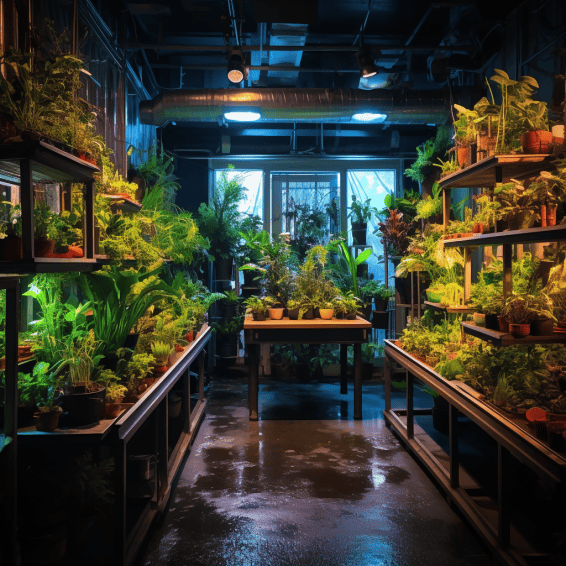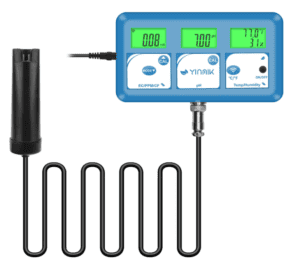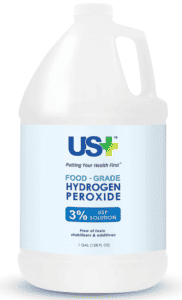According to hydroponics guru Alicia, “Test and adjust pH levels weekly to keep plants healthy.”
Through firsthand experience, I’ve learned how crucial proper pH is for nutrient uptake.
The ideal range is 5.5-6.5.
I use an affordable meter to test weekly and balance acidity with solutions if needed.
By maintaining stable pH, I’ve grown healthier herbs and vegetables that mature faster with few issues.
Keep reading to learn the ideal pH range for hydroponics and how to test and adjust levels.
Get tips to maintain stable pH for bigger, faster harvests.
KEY TAKEAWAY
What to know about maintaining hydroponic garden?
Maintaining a hydroponic garden involves regular checks, precise nutrient calibration, gentle pruning, and diligent cleaning, ensuring optimal plant health and system efficiency. (1)
Essential Hydroponic Maintenance Tasks
Source: Humble Growth Hydroponics
Here is a quick guide to hydroponic maintenance from my experience as an avid hydroponic gardener:
Monitor Water Quality
As a hydroponic farmer, monitoring pH and electrical conductivity (EC) levels has been vital.
pH indicates nutrient availability, with an ideal range of 5.5-6.5 for hydroponics.
I check pH 2-3 times weekly and use pH Down to lower levels if needed.
EC measures total dissolved salts.
Tracking EC along with pH ensures nutrients are balanced so plants can uptake what they need.
Change Nutrient Solution Weekly
I change my hydroponic system’s nutrient solution weekly to prevent buildup of salts and pathogens like root rot.
I use hydrogen peroxide to sterilize reservoirs, trays, pipes – keeping the system debris-free is crucial, as decay spreads fungi and mold.
I wipe down all surfaces before each nutrient change.
Inspect Roots and Oxygenate Water
Every week I inspect roots for signs of disease like brown lesions or foul odor, which indicate root rot.
Healthy roots are white.
I also confirm air stones or water pumps are running properly to oxygenate the nutrient solution, which prevents root diseases.
I use two air stones per 10 gallon reservoir.
Rinse Filters Regularly
I rinse pre-filters daily and replace main filters monthly to remove debris before clogging occurs.
Clean filters mean efficient hydroponic systems.
By staying on top of these simple maintenance tasks, I sustain a thriving, high-yield hydroponic garden!
Proper sterilization, oxygenation, and filtration helps me grow robust, healthy plants.
Hydroponic Reservoir Maintenance
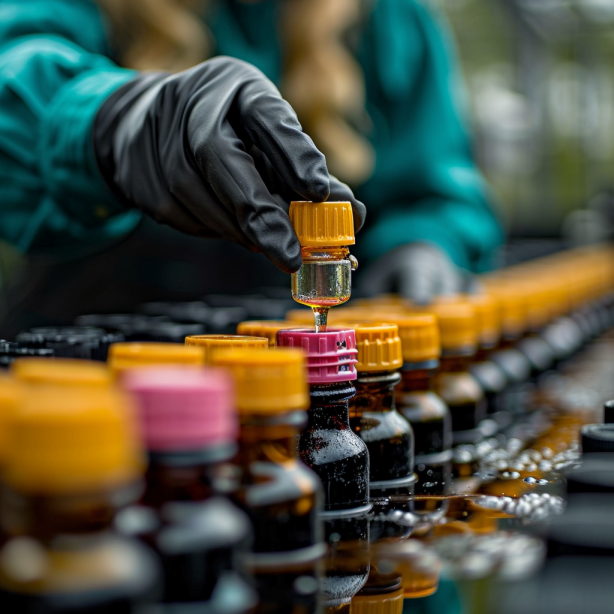
Maintaining Proper Nutrient Solution Temperature
Keeping nutrient water between 65-75°F is vital for healthy roots and plant growth.
I use aquarium heaters and track temperatures daily.
Fluctuations outside the ideal range cause issues like nutrient lockout.
Top-Off Procedures and Water Changes
I top off my 50 gal reservoir with pH adjusted RO water whenever levels drop 5 gal to maintain volume.
Nutrient concentrations then stay steady between my weekly 25% water changes.
I find this frequency prevents salt build ups while replenishing nutrients plants need.
Aeration and Filter Cleaning
Proper oxygenation and filtration prevents diseases.
I use dual air stones on separate air pumps to vigorously bubble water.
I also clean pre-filters daily, swapping main filters monthly.
Clogged filters limit oxygen and water flow.
By staying on top of these two maintenance tasks, my plants thrive in a clean, aerated system.
Proper reservoir care has been key for my successful deep water culture and NFT hydroponic gardens.
Maintaining stable nutrient temperature, changing water weekly, and ensuring…
… filtration and aeration takes work but pays off with healthy plants. (2)
Advanced Hydroponic System Care
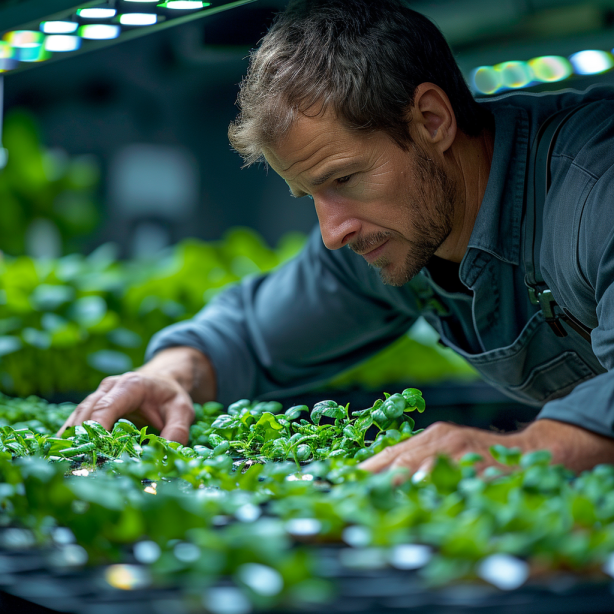
Troubleshooting Common Hydroponic Issues
In growing hydroponically, common issues like nutrient imbalances, algae blooms, fungus gnats, and root rot can occur.
But every problem has a solution:
- Nutrient deficiencies – Testing pH and EC levels using meters, aiming for 5.5-6.5 pH and 1.2-2.2 mS/cm EC prevents lockouts.
- Algae growth – Using sterile reservoirs and changing nutrient solution weekly prevents algal blooms. Hydrogen peroxide works too.
- Fungus gnats – Letting the top layer dry out kills larvae in soil. Sticky traps catch adults. Bacillus thuringiensis also works.
Choosing the Right Hydroponic System for Easy Maintenance
When starting out, consider choosing an easy-to-maintain hydroponic system:
- Passive systems like deep water culture and nutrient film technique don’t require daily watering, allowing for less frequent maintenance.
- Smaller systems are simpler for beginners. Scale up the size as experience grows.
Factors like automation and size should be considered when selecting a hydroponic setup for easy care and success.
Establishing a Maintenance Schedule
Growing plants hydroponically allows you to provide nutrients and water precisely when needed.
Following a regular maintenance schedule is key to preventing issues like root rot and maintaining healthy plant growth year-round.
I clean my small home hydroponics system once a week.
Commercial growers with large-scale systems may need daily testing and water changes.
Get to know your system!
Test pH and EC Levels
Use a meter to track the pH and EC (amount of dissolved nutrients) in your system’s water and nutrient solutions.
Most plants thrive best with a pH between 5.5 and 6.5.
If the pH drifts too high or low, nutrients become unavailable to plants.
An EC meter ensures the right nutrient balance.
Test and record pH and EC weekly or more often.
Change Nutrient Water
The amount of dissolved oxygen and nutrients starts declining after about a week, leading to root issues.
Change some or all nutrient water in your hydroponics system regularly, depending on system size.
Small systems may need weekly or biweekly changes.
Larger systems need more frequent cycling.
Clean All System Parts
Over time, mineral deposits, algae, and biofilms can build up in tubes, pumps, and reservoirs.
Use a mild, plant-safe cleaning solution to scrub away gunk and disinfect system parts.
Rinse thoroughly before refilling your system with fresh nutrient water.
Using Appropriate Cleaning Agents
The right hydroponic system cleaning agents remove buildup without harming plants or equipment.
Hydrogen Peroxide
As an oxidizing agent, hydrogen peroxide breaks down organics and kills pathogens.
Use a 3% solution, available at pharmacies.
Rinse thoroughly after cleaning.
White Vinegar
The acetic acid in white vinegar dissolves mineral deposits and kills bacteria and fungi.
Use full strength, then rinse.
Avoid products with added fragrance or color.
Lemon Juice
Like vinegar, lemon juice tackles hard water deposits and disinfects.
Use pure lemon juice.
The acidity varies, so test on a small area first before cleaning the entire system.
Mild Plant-Safe Soaps
Look for plant-safe, fragrance-free castile or peppermint soap to scrub away biofilms without leaving toxic residue.
Dr. Bronner’s and other green brands work well.
Keeping a Maintenance Log
Track your system’s pH, EC, cleaning schedule, and other maintenance in an ongoing log.
Note things like:
- Daily pH and EC readings
- Water changes
- Cleaning dates
- Unusual issues noticed
Reviewing records helps spot patterns over time so you can tweak your system to improve results.
For example, you may decide to change nutrient solutions twice a week instead of once.
Recording maintenance also reminds you of last completion dates so you stay on schedule.
Consistent, attentive care is essential for controlled environment agriculture.
Following this 3-step guide to maintain your hydroponics system helps ensure healthy plant growth year-round.
Test and change nutrient water regularly, use appropriate cleaners to prevent buildup, and keep an ongoing log to improve efficiency.
Doing hydroponic system maintenance right takes work but pays off with thriving plants.
Frequently Asked Questions
How do I maintain my hydroponic nutrient reservoir?
The key to maintaining a healthy hydroponic nutrient reservoir is to keep track of nutrient levels and change out the water on a regular schedule.
Always use filtered or clean water when refilling your reservoir.
Cleaning your hydroponic system regularly can also help prevent algae growth and keep nutrient levels stable.
What is the best way to clean my hydroponic system?
There are a few different ways to clean your hydroponic system depending on the type of system and plants you are growing.
For nutrient film technique systems, you may need to change out the water more frequently.
Rinsing out growing containers with fresh water is also important.
Be sure to use food grade cleaning products safe for use around your hydroponic plants.
Maintaining clean water and a clean reservoir will help your plants thrive.
How do I keep my hydroponic nutrients at the right levels?
Measuring and maintaining the proper EC levels and pH of your nutrient solution is key to successfully growing hydroponic plants.
Get a quality EC and pH meter and check measurements regularly, such as once every few days.
Adjust nutrient levels as needed based on the specific hydroponic nutrients you are using.
Refer to the nutrient label or a nutrient chart for the ideal EC range for your crop type.
What types of grow lights are best for hydroponic gardening?
There are a few popular types of grow lights suitable for hydroponic gardening, depending on the size of your grow area and preferences.
LED grow lights have become very efficient and affordable in recent years.
They provide strong full-spectrum lighting ideal for most plants.
Fluorescent grow lights also work well for smaller hydroponic growing spaces.
Make sure to keep your grow lights sufficiently close to the plants for best results.
Refer to the light manufacturer recommendations for height and photoperiod guidance.
How do I keep track of my hydroponic plants’ nutrient needs?
To keep your hydroponic plants healthy, it’s important to monitor their nutrient and water needs over time.
Regularly check plant size and growth rate to determine if they need more or less of certain hydroponic nutrients.
Carefully watching for any deficiency or toxicity symptoms can help guide your nutrients amounts.
Keep good records of the types of plants grown, nutrient solution EC and pH levels, and any changes made.
This makes it easy to tweak your system as seasonal growing conditions change.
What are some tips for maintaining food safety with hydroponic gardening?
When growing food crops hydroponically, it’s important to maintain the highest standards of food safety.
Always use clean, food grade materials that are resistant to microbial growth.
Filter water entering your nutrient reservoir and clean your hydroponic system thoroughly on a regular schedule.
Practice good hygiene when working around plants.
Control pests and monitor for any signs of spoilage or disease.
Letting produce fully dry before packaging or eating can also reduce risks.
With proper safety precautions, hydroponics can produce very clean, pesticide-free foods.
Conclusion
Consistently maintaining your hydroponic system is crucial for healthy plants and optimal growth all year round.
By regularly checking EC and pH levels, changing nutrient solutions weekly, and…
… cleaning the system every 2 weeks, you can prevent issues like root rot and dial in the perfect environment for your crops.
Don’t hesitate to leave a comment below if you have any other hydroponics care questions!
References
- https://floraflex.com/default/blog/post/how-to-maintain-your-hydroponic-reservoir
- https://agradehydroponics.com/blogs/a-grade-news/reservoir-maintenance-the-dos-and-donts
Related Articles
- https://tophydroponicgarden.com/how-to-maintain-your-first-hydroponic-garden/
- https://tophydroponicgarden.com/hydroponics-for-beginners/
- https://tophydroponicgarden.com/hydroponic-supplies-basics/
Was this helpful?

I’m Barrie L., a passionate hydroponic gardening enthusiast dedicated to cultivating thriving, soil-less gardens. With a focus on all things hydroponic, I share my expertise on innovative growing techniques and sustainable practices through my blog, tophydroponicgarden.com. As a seasoned hydroponics specialist, my goal is to inspire and guide fellow gardeners in harnessing the power of water-based cultivation for bountiful and eco-friendly harvests. I’m also an author of the book “Hydroponics For Absolute Beginners: Your Step By Step Guide For How To Create An Hydroponics System At Home Without Soil, For Growing Vegetable, Fruit And Herbs.” which is sold on Amazon. Join me on a journey of redefining the way we cultivate plants, one nutrient-rich solution at a time. Happy growing!

